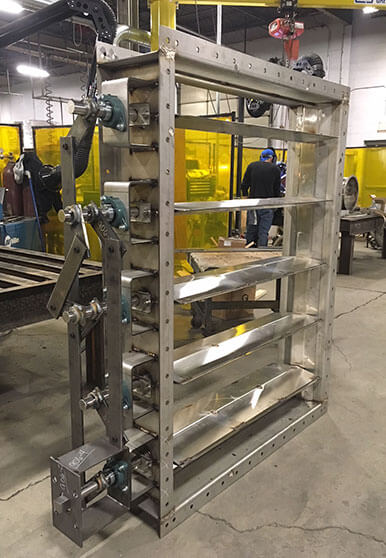
Industrial Louver Dampers
Kelair Louver dampers modulate and isolate the flow of air or gas in a system
Download our BrochureKelair Dampers Brochure

Industrial Louver Dampers that feature quick actuation, control and isolation
Kelair Louver Dampers or Multi-Vane Dampers consist of several blades mounted parallel across a duct. These are commonly found in applications across multiple industries. They modulate the flow of air and gas in mostly dry conditions or can isolate and shut them off altogether. Opposed blade carbon steel and stainless-steel louvers allow the flow to increase or decrease with high precision. Parallel blades allow for complete shut off and are particularly useful where space is restricted.
These industrial dampers are frequently motorized or can be manually adjusted for flow control. Louver dampers control gas or air flow, detour flow into separate systems, or isolate a process for inspection and maintenance. Motorized louver dampers are particularly useful in applications where quick actuation and space constraints are major issues. Louver dampers are adaptable, can be lightweight, compact and have low leakage to the outside environment.
*Operational testing and calibrating are completed at the factory prior to installation.


Key Features & Specifications
Kelair’s industrial louver dampers are built with performance and flexibility in mind. Key features include:
- Sizes Available: 14″ to 132″
- Configurations: Round, square, or rectangular shapes with parallel or opposed blade options
- Materials: Stainless steel and painted carbon steel (other materials available upon request)
- Actuation Options: Manual, electric, or pneumatic (spring return and failsafe options available)
- Temperature Capability: Handles process temperatures up to 2100°F
- Pressure Rating: Up to 1 PSI and 4000 FPM of process air; higher ratings available upon request
- Seal Options: Compression, jamb, metal seat, and swing-thru for effective shutoff and flow control
- Shutoff Capability: Up to 99%
- Blade Functionality: Modulating or full shutoff capability depending on parallel or opposed blade configuration
- Performance Enhancements: Standard ball bearings and shaft packing glands for longevity and efficiency
Our industrial control dampers are ideal for systems requiring low-leakage, compact components with smooth and reliable actuation.
Benefits of Choosing Kelair’s Louver Dampers
Choosing Kelair means choosing a partner with more than 130 years of combined engineering expertise. Each louver damper is custom-built to meet the specific needs of your operation, providing tailored solutions for even the most complex airflow challenges.
Kelair stands out with its industry-leading lead times:
- Standard delivery: 4-5 weeks from approved drawings
- Expedited delivery: 3-4 weeks
- Without actuator: as fast as 2-3 weeks
Every louver damper undergoes factory operational testing and calibration prior to shipping, ensuring reliable performance right out of the box. And with direct access to knowledgeable professionals, customers enjoy quick answers, informed decisions, and responsive support without the hassle of corporate red tape.
Common Industrial Applications
Kelair’s louver dampers are trusted across a wide range of industries thanks to their ability to handle extreme conditions and deliver consistent air flow control. Common use cases include:
- Power Generation: Managing air flow in combustion systems and exhaust streams.
- Manufacturing & HVAC: Controlling ventilation and air flow for efficient environmental management.
- Pollution Control: Helping to manage emissions and improve air quality in industrial operations.
- Refineries & Chemical Plants: Directing high-temperature gas flows in complex processing environments.
These versatile industrial control dampers are ideal for systems requiring quick actuation, precise modulation, and reliable isolation.
How to Request a Custom Quote
We make it easy to get started with a custom damper solution. To ensure an accurate and timely quote, be prepared to provide:
- Damper type (louver, butterfly, etc.)
- Preferred material (stainless steel, carbon steel, other)
- Pressure and temperature requirements
- Air flow specifications
- Desired actuation method (manual, electric, pneumatic)
- Target shutoff performance (percentage)
Whether you need a control damper for flow regulation or a control valve alternative for directing air flow, our team will review your specifications and provide a quote tailored to your application.
Contact Kelair today for a custom-engineered solution.
Commonly Asked Questions About Louver Dampers
- What are the benefits of a louver damper?
- What types of seals can be used on a louver damper?
- What kinds of applications are louver dampers ideal for?
- What can cause linkages to operate ineffectively on louver dampers?
- How often should packing glands be changed out?

